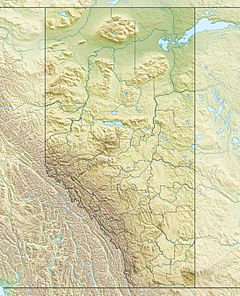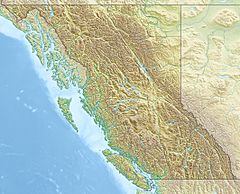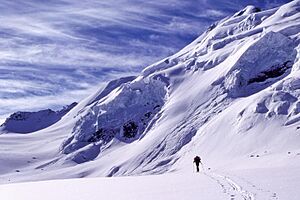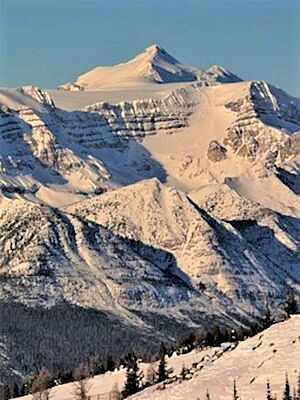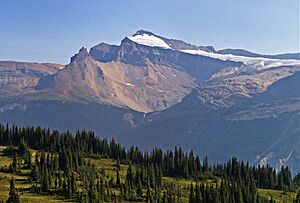Mount Balfour facts for kids
Quick facts for kids Mount Balfour |
|
|---|---|

Mount Balfour from Iceline Trail
|
|
| Highest point | |
| Elevation | 3,284 m (10,774 ft) |
| Prominence | 934 m (3,064 ft) |
| Parent peak | Howse Peak (3295 m) |
| Listing | Mountains of Alberta Mountains of British Columbia |
| Geography | |
| Country | Canada |
| Parent range | Waputik Range |
| Topo map | NTS 82N/09 |
| Climbing | |
| First ascent | 1898 C.L. Noyes, C.S. Thompson, G.M. Weed; Appalachian Mountain Club |
Mount Balfour is a tall mountain found right on the Continental Divide. This means it sits on the border between British Columbia and Alberta in Canada. It's part of the Waputik Range within the amazing Canadian Rockies.
This mountain is quite high! It's one of the tallest peaks in both Alberta and British Columbia. A man named James Hector gave the mountain its name in 1859. He named it after Professor John Hutton Balfour, who was a Scottish botanist (someone who studies plants). Professor Balfour was one of Hector's teachers at the University of Edinburgh.
Contents
Climbing Mount Balfour
People have tried to climb Mount Balfour for a long time. Early attempts often started from Sherbrooke Lake.
First Ascent of Mount Balfour
The very first time someone successfully reached the top was on August 18, 1898. The climbers were C.L. Noyes, C.S. Thompson, and G.M. Weed. They were all members of the Appalachian Mountain Club.
Their journey began from Hector Lake. To get there, they crossed Dolomite Pass to Bow Lake. Then, they continued south to reach Hector Lake. Other groups, like the ACC, also climbed Balfour later.
How Mount Balfour Formed
Mount Balfour is made of sedimentary rock. This type of rock forms from layers of sand, mud, and tiny bits of sea creatures. These layers were laid down over millions of years, from the Precambrian to the Jurassic periods.
The Laramide Orogeny
Long ago, these rocks were in shallow seas. Then, a huge event called the Laramide orogeny happened. This was a time when the Earth's plates pushed together. This powerful force pushed the sedimentary rock layers east. It even pushed older rock on top of younger rock. This is how the amazing mountains we see today were formed.
Weather at Mount Balfour
Mount Balfour has a subarctic climate. This means it has very cold and snowy winters. The summers are usually mild, not too hot.
Winter Conditions
In winter, temperatures can drop very low, sometimes below −20 °C. When the wind blows, it can feel even colder, sometimes below −30 °C. It's a very chilly place in the colder months!


